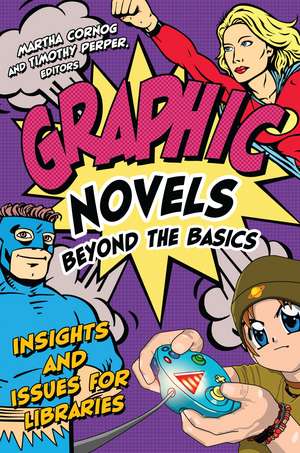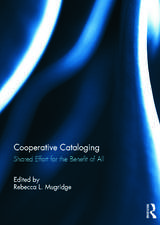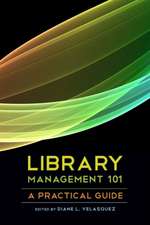Graphic Novels Beyond the Basics: Insights and Issues for Libraries
Editat de Martha Cornog, Timothy Perperen Limba Engleză Paperback – 24 aug 2009 – vârsta până la 17 ani
Preț: 266.45 lei
Preț vechi: 322.56 lei
-17% Nou
Puncte Express: 400
Preț estimativ în valută:
50.99€ • 55.37$ • 42.83£
50.99€ • 55.37$ • 42.83£
Carte tipărită la comandă
Livrare economică 23 aprilie-07 mai
Preluare comenzi: 021 569.72.76
Specificații
ISBN-13: 9781591584780
ISBN-10: 1591584787
Pagini: 312
Ilustrații: black & white illustrations
Dimensiuni: 156 x 235 x 23 mm
Greutate: 0.48 kg
Editura: Bloomsbury Publishing
Colecția Libraries Unlimited
Locul publicării:New York, United States
ISBN-10: 1591584787
Pagini: 312
Ilustrații: black & white illustrations
Dimensiuni: 156 x 235 x 23 mm
Greutate: 0.48 kg
Editura: Bloomsbury Publishing
Colecția Libraries Unlimited
Locul publicării:New York, United States
Caracteristici
Thoroughly indexed to ease access, including a detailed subject index as well as a creator and title index of key graphic novels
Notă biografică
Martha Cornog is a freelance researcher and writer and has written the graphic novel column for Library Journal since 2006. Timothy Perper is review and commentary editor for Mechademia: An Annual Forum for Anime, Manga and the Fan Arts.
Cuprins
AcknowledgmentsIntroduction: Origin StoriesMartha Cornog and Timothy PerperA Quick History of Comics and Graphic NarrativeComics, Graphic Novels, and LibrariansAbout Comics TodayAbout This BookNotesReferencesPART I: THE LITERATUREChapter 1: The Allure of the SuperheroMichael NiederhausenWhat Is a Superhero?Superhero HistoryWho Loves Superheroes?Significant SuperheroesKeeping CurrentSuperhero Programs in LibrariesNotesReferencesChapter 2: Japanese MangaRobin BrennerOrigins and InfluencesThe Manga BoomManga Audiences, Symbols, and LiteracyCultural Road BumpsCollection DevelopmentMaking Manga's Appeal Work for You: Programs and Your CommunityPutting It All TogetherNotesReferencesChapter 3: Girls, Women, and ComicsTrina RobbinsWhat? Girls Read Comics?Women and Comics: A Long TraditionSo What Do Girls Want? Collection DevelopmentAssessing Interest and Keeping Up: What's Hot?Your Community: How to Get Girls into Your LibraryGirls, Women, and Comics: RepriseNotesBibliographyChapter 4: American Comics: Beyond the Superhero, Part One, Genre FictionMichael R. LavinIntroducing the Broader VistaAn Overview of GenresConclusion: Genres ReduxChapter 5: American Comics: Beyond the Superhero, Part Two, General Fiction and NonfictionMichael R. LavinGraphic Novel AdaptationsRealistic FictionAutobiography/MemoirOther Types of NonfictionConclusionSuggested ResourcesChapter 6: Graphic Novels: A Global LiteratureIntroductionMartha CornogPart 1: The Global Context of Graphic NarrativeJohn A. LentPart 2: A Librarian's Guide to International Graphic NovelsMartha CornogNotesReferencesPART II: GRAPHIC NOVELS AND THE LIBRARYChapter 7: A Place in the LibraryFrancisca GoldsmithCollection DevelopmentAcquisitionsBibliographic AccessCollection PlacementCirculation IssuesPreservation and Collection MaintenanceThe Future of Graphic Novels in LibrariesNotesReferencesChapter 8: Comics and Graphic Novels in the Academic Library CollectionLorena O'EnglishComics and Higher Learning: An IntroductionGraphic Novels in the Academic SettingIssues Unique to Academic Library CollectionsCase StudiesConclusionResourcesNotesAppendix AChapter 9: Japanese AnimeGilles PoitrasBefore We Go Any Further: Some DefinitionsCharacteristics of Anime and MangaWhat about Problematic Content?Collection-Development ConsiderationsAnime: Fans, Programs, and Your CommunityWhat Shall the Future Bring?NotesReferencesWeb Site ReferencesChapter 10: Censorship of Graphic Novels in LibrariesMartha Cornog and Erin ByrneA Picture Is Worth a Thousand WordsThe Way It Is: Graphic Novels and ChallengesForestalling Complaints and Challenges: StrategiesDealing with Objections and ChallengesCase StudiesCommentary and ConclusionsFigure 1: Sample Request for Reconsideration of Library ResourcesNotesReferencesAppendix A: Graphic Novels and GamesRobin BrennerAppendix B: Guide to Graphic Novels in Special TopicsMartha Cornog1 African American-Interest Graphic Novels: Resources2 Latino-Interest Graphic Novels: Resources3 LGBT-Interest Graphic Novels: Resources4 Religious-Themed Graphic Novels: ResourcesAppendix C: Bibliography of Books: Graphic Novels, Libraries, and LiteracyMartha CornogAppendix D: Selected Online ResourcesMartha CornogIndexAbout the Editors and Contributors
Recenzii
The editors of this engaging guide assert that graphic literature is not just a genre but rather an effective literary medium. They sustain their argument through a brief but insightful historical recap, an overview of evolving critical commentary, updated statistics touting ubiquitous growth, a nod to literacy-related research, and testimonials from librarians-all in the introduction. . . . This useful and entertaining guide is recommended for public and academic libraries, for both nascent and established graphic collections.
Any old time librarian who wants to better understand the graphic novel and decide if their library should begin to carry them needs to consider Graphic Novels: Beyond the Basics as an educational introduction and reference to the category.
In this collection of ten chapters by librarians, graphic novel writers, and others based in the US, Cornog and Perper introduce librarians to graphic novels. Chapters explain genres, superhero comics, manga, graphic fiction and nonfiction, comics for girls and women, international comics, and issues relating to purchasing, cataloging, preserving, collecting related media like anime films and video games, collecting for academic libraries, and dealing with potential complaints and censorship. Core lists of recommended titles are included, and an appendix lists graphic novels of interest to AfricanAmericans, Latinos, LGBT patrons, and those interested in religious themes.
This work is of value not only to the librarian, but also to the educator wishing to incorporate the graphic form into their classroom.
Contributors to this book include librarians, scholars, and publishers, giving the reader a well-rounded perspective from trustworthy sources. The tone is encouraging and empowering, and the information and advice is practical. This title would be an asset to any public library professional collection. Content is useful to library media specialists, academic librarians, and teachers and should be considered by those teaching in library science and media programs at the graduate level. It will serve as a reference resource to those developing a core collection, planning programs around graphic novels, academic libraries considering adding or expanding a graphic novel collection, and those writing policies or dealing with challenges of the format.
Whether you are serious about the genre, interested in the history, or looking for ammunition, this book should be on your shelf. The wealth of knowledge and research that went into these essays is impressive, and reading this book will put you on the road to becoming an expert. . . . Highly recommended.
highly informative . . . there is much to enjoy and inform in this volume.
Any old time librarian who wants to better understand the graphic novel and decide if their library should begin to carry them needs to consider Graphic Novels: Beyond the Basics as an educational introduction and reference to the category.
In this collection of ten chapters by librarians, graphic novel writers, and others based in the US, Cornog and Perper introduce librarians to graphic novels. Chapters explain genres, superhero comics, manga, graphic fiction and nonfiction, comics for girls and women, international comics, and issues relating to purchasing, cataloging, preserving, collecting related media like anime films and video games, collecting for academic libraries, and dealing with potential complaints and censorship. Core lists of recommended titles are included, and an appendix lists graphic novels of interest to AfricanAmericans, Latinos, LGBT patrons, and those interested in religious themes.
This work is of value not only to the librarian, but also to the educator wishing to incorporate the graphic form into their classroom.
Contributors to this book include librarians, scholars, and publishers, giving the reader a well-rounded perspective from trustworthy sources. The tone is encouraging and empowering, and the information and advice is practical. This title would be an asset to any public library professional collection. Content is useful to library media specialists, academic librarians, and teachers and should be considered by those teaching in library science and media programs at the graduate level. It will serve as a reference resource to those developing a core collection, planning programs around graphic novels, academic libraries considering adding or expanding a graphic novel collection, and those writing policies or dealing with challenges of the format.
Whether you are serious about the genre, interested in the history, or looking for ammunition, this book should be on your shelf. The wealth of knowledge and research that went into these essays is impressive, and reading this book will put you on the road to becoming an expert. . . . Highly recommended.
highly informative . . . there is much to enjoy and inform in this volume.










